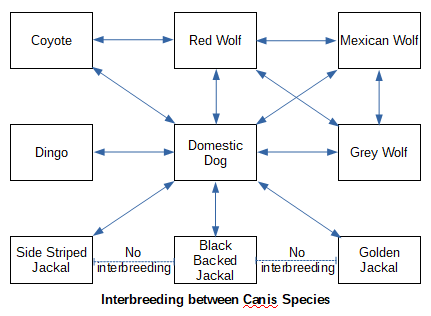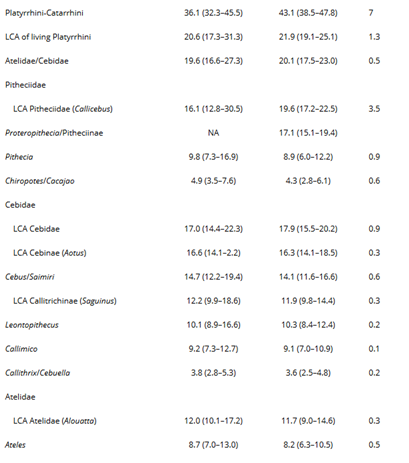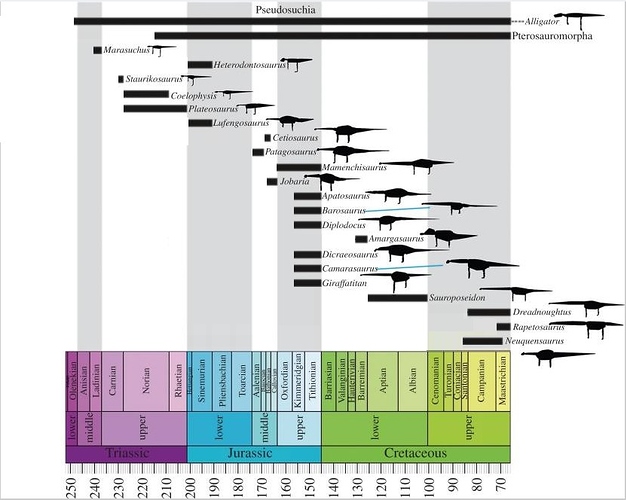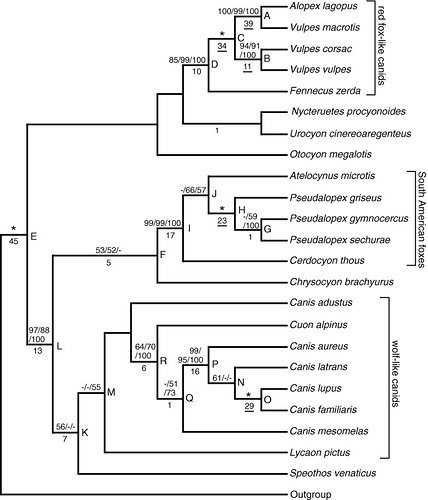So let me explain it a bit more clearly. The diagram in figure 1 shows the extent of actual fossil evidence by the black bars, and the hypothetical parts by the thin lines. Remove the hypothetical parts and what you are left with is a collection of fossils that generally appear without clear evidence of ancestors, and disappear without clear evidence of descendants. The “transitional fossils” disappear.
This all seems well said and helpful, at least to this non-scientist’s understanding. But I don’t understand what you’re getting at when you write:
Why “at best”? If you assume life has been evolving on the earth over a long period of time, why not make this assumption?
But what is the alternative? I’m assuming you do accept that some extinct species were transitional and in line of descent between older phenotypes and later ones, whether still extant or not. Otherwise do you assume that every living species as well as the many prehistoric ones had a common beginning time?
Hmm. I was slightly ambiguous there. How about
Even if you find a fossil that is intermediate in form and time it is still very difficult to show that it is in the line of descent; at best it might be transitional; i.e you can hypothesise that it is transitional but you can’t prove it.
No I don’t think that every living and extinct species had a common beginning. The large number of species we have today have devolved from the survivors of Noah’s Flood. Noah only had to take a pair of the dog kind to produce domestic dogs, coyotes, dingoes, wolves, and jackals. Note that some hybrids, such as between Dingo and Coyote, might be possible but have not yet been established.

Do you then believe that Noah’s flood was global? I find that surprising. From your dog example, do you actually think that from one form of canis it would really be possible to differentiate into all the wild forms we find today? My understanding is that domesticated dogs represent a neonatal arrested-development form of a wolf. I believe domesticated dogs are only thought to have developed from wolves 40 to 50 thousand years ago.
But doesn’t the Noah story make more sense on a local scale? When the polynesians radiated out over the Pacific ocean they brought with them the animals and plants they depended on. Surely that makes more sense than literally housing every species still alive along with the many we’ve driven into extinction since?
Do you know why those lines are on the graph? Or how phylogenies based on morphology are made? Or how about genetics:
The original dog kind was probably similar to the wolf. Many domestic dogs are mutants that wouldn’t survive in the wild. The domestic dog is in the centre of the diagram because it has been spread around the world by humans and so has had the opportunity to interbreed with all the wild types, but it is not meant to imply that all wild dogs are descended from domestic dogs. There is currently an interesting program of domesticating foxes which is showing that selecting for friendliness to humans causes a range of different traits to emerge.
Why would you consider “literally housing every species still alive along with the many we’ve driven into extinction” when I’ve already said that most extant species developed post Flood.
Of course Noah’s Flood was global. Isn’t that what the Bible says? Following the Flood and Babel as people dispersed they would have taken with them animals and plants they depended on but probably a different mix for each group and these would also have changed while they migrated to suit the different climates they encountered. So the Polynesians at some stage adopted root vegetables as one of their staples since grains aren’t suited to tropical climes and spread those around the Pacific.
You choose the key characteristics and put it into a Cladogram program that assumes common ancestry and will arrange them into the most parsimonious tree. You could put an assortment of nails, screws, and bolts into such a program (and use a hammer as the outgroup) and produce a phylogenetic tree even though it is clear there is no line of descent anywhere. Since the tree structure is assumed at the start that is what is produced.
Of course it is difficult to do the genetic part of phylogenetic on dinosaurs.
Because you have put both foxes and wolves into the same data set the program will produce the “common ancestors” even if they never existed. i.e. Ghost Lineages.
I guess those ghost lineages are the transitional fossils that aren’t found.
We just about got there. Here’s a nice overview of how you can test whether the relationships you find are real or not: https://embnet.vital-it.ch/CoursEMBnet/PHYL03/Slides/Assesment_mwilkinson.pdf
You can put things like nuts and bolts into such a tree and group them in various ways. That is so different from comparing genomes or fossils it can’t come close to comparing. Plus, nuts and bolts don’t reproduce or have small variations over time in their offspring! If you just looked at a few characteristics then you would have less confidence in true common ancestry but what if you looked at hundreds of millions of base pairs or tens of thousands of Erv or Alu insertions–that doesn’t even compare to making a tree with non-reproducing tools.
Though it wouldn’t be if they lived just a few thousand years ago.
The shocking thing is that nobody can produce any clear demarcation lines to show when (if ever) there was definitely not a common ancestor between ancestral wolves and ancestral foxes. We can estimate the time to most recent common ancestor and compare it with fossil evidence. If they really were not related, the TMRCA should give a result much, much, much, much bigger than what could be deduced from the fossil record because morphological similarities do not require genetic similarities (especially at the single base pair level). Here’s a nice comparison of the two:

Here’s a nice example of how a new fossil find (a) always fits into existing patterns and (b) can shrink down such ghost lineages and (c) such trees can be used to find new fossils!:
https://royalsocietypublishing.org/doi/full/10.1098/rsos.140184
Hi, Daniel! I haven’t been around here for a while and I don’t think I’ve seen you before, hope you don’t mind me jumping in belatedly!
CO2 scrubbers could be added to automobiles, but the expense so far has not been deemed worth the benefit. Sonar on the space shuttle, on the other hand…sonar is sound-based navigation. Sound travels only through making waves in mediums like air or water. Sound doesn’t travel through space. So as soon as you left the atmosphere sonar would be useless.
Gills for seals, manatees, or dolphins, on the other hand, would seem like extremely useful tools, even if only as a supplement to air-breathing.
The original argument about transitional fossils was from a hundred years ago when there were hardly any transitional fossils, as in intermediate in form, discovered yet. The argument was a sensible one then, but rather than give it up when truly excessive numbers of fossils “intermediate in form” were discovered over the decades, some people have been industriously shifting goalposts to “You can’t prove direct descent so it doesn’t count as a real transitional fossil!” Can we agree there are many examples of transitional-in-form fossils and that transitional-by-direct-descent is all but impossible to prove realistically?
When Darwin made his prediction that we should find many more transitional fossils than were available in his day, he certainly wasn’t expecting genetic proof of descent or precisely dated radiometric ages in order for his prediction to be fulfilled! All he meant was that we should see fossils that were intermediate in form and in approximately the correct geological strata. All the fuss about proving direct descent is just to distract from how well his prediction has been borne out.
If the underlying genetic code showed improbable similarity between a duck and a duckbill platypus, using the same genes with the same variations in them to grow the ‘duck beak,’ that would be an indication of lateral gene transfer. We find examples in bacteria of genes that are shared laterally rather than by descent, but animals don’t have that kind of mixing and matching occurring on any kind of scale. All the examples of convergent evolution look completely different when we look at the genes, as we’d expect. When we find similar forms or functions underlain by similar genetic architecture, it’s always because the organisms are closely related according to the tree of descent.
I wonder if you’ve ever looked into the work people have done on the evolution of multicellular life? This article seems like a good current overview, and should give you a lot of things to look into if you want to learn more. You could find many other similar articles if you tried googling, on multicellularity or the Cambrian explosion or echolochation or anything else you have a curiousity about.
Please feel free to jump in, of course!
What benefit??? It isn’t about the expense, but rather that there is simply no need based on what cars are made to do. When they destined cars, they didn’t leave out the CO2 scrubber because it was deemed to expensive, it just wasn’t even considered as it was useless. If by some bizarre chance you really need to get rid of accumulated CO2, you can simply roll down the window. We don’t have that luxury in submarines, nor do astronauts in space shuttles, as I understand it…! ![]()
In a very similar way, you could add sonar to the space shuttle, but it would similarly be needless.
And legs and air-breathing lungs for fish could prove useful, and gills for birds, and wings for dogs, and echolocation for rhinoceros, and a poison stinger for an owl… for that matter I’d find gills and wings and echolocation (and maybe even a poison stinger occasionally) useful on my body. All these could be useful, theoretically, but I’m not sure of the point?
Cars are a major reason that CO2 levels in the atmosphere have been skyrocketing (this is measurable fact) and CO2 along with methane and other waste byproducts are (a/the) major reason why the Northwest Passage keeps getting more and more clear of ice every year. But installing CO2 filters into individual cars would be a pretty ineffective method of solving this problem, and also we would be veering off the topic of this forum which is not about greenhouse effects. Thanks for clarifying that you weren’t providing it as a serious example, I didn’t quite understand your position.
I think that’s an excellent point. In a sense, most fossils are “transitional fossils” since life is continually evolving. The only fossils that wouldn’t count as transitional would be those of “dead end” species (such as all non-avian dinosaurs at the time of the Cretaceous Extinction Event). So. Just two types of fossils – dead-end fossils and transitional fossils…
![]() gets my vote for coolest news article of the month!
gets my vote for coolest news article of the month!
(It would go for longer than that, except that at the beginning of March there was that hubbub over the discovery of a new orca species that is arguably cooler…)
Indeed it’s possible there was a common ancestor but because the mechanics of Cladistics will always produce a common ancestor of the groups being compared that does not provide proof that such a common ancestor existed. It’s circular reasoning, the methods of constructing a phylogenetic tree assume the very thing they purport to show.
And you appear to again reject methods that we can use to test whether such a tree is a better fit than no tree. It’s not really too hard though… You see that there were small changes in pretty every lineage of every species, with shared morphology and shared genetic sequences- even shared pseudo genes for more closely related species. We also see things like the pattern of single nucleotide mutations amongst humans matches the pattern of single nucleotide mutations when comparing humans to chimpanzees only less and magnitude. There is no evidence that there was not shared ancestry anywhere in the entire world.
The rest of my post also outlined how many phylogenetic trees were maybe just nice ways of organizing things but when tested against genetic data, provide even more and stronger evidence of common ancestry. And then ghost lineages (which you seem to indicate suggest a lack of common ancestry despite most of the lineage is at least that you mentioned I’ll be in within the boundaries of the YEC ‘kind’) Can actually be used to predict and find new fossils and lineages. There is nothing with the spontaneous creation of fully formed organisms that has ever done such nor can it.
And dead-end organisms and transitional organisms. Today, that is…
So it would be impossible to define an existing species as “transitional”?
And what do you say to a YEC when they respond that what you are describing are not “transitional” but “complete and isolated species” that God created, distinct from any other species?
Abrupt means not slow and gradual in the way expected. Abrupt means absence of the logical, normally expected gradual sequence of change. Abrupt means an absence of expected intermediaries, absence of necessary transitionals. Absence not only for one species or genera, but absence of many transitionals for many genera. Sudden appearance of many different life forms.
Maybe this, maybe that… but in fact it doesn’t matter how informed he was about conditions of formation, since his conclusion is still the same, whatever conditions applied to observed species would apply to transitionals.
Question is, what are paleontologists looking for? What was Darwin looking for? Why did he make the statement, and why did the other scientists agree with him and also make the same conclusion?
Might or might not… but it doesn’t matter. Under assumptions for transitions, the statement is often made that all species are transitional, so therefore there is no logical reason to suppose that so many transitionals could not survive, while the rest did survive. And if they did not survive for a long time, then how could they survive long enough to be transitional, without leaving fossils. We do not see evidence today of that type of process.
An eel, with no observable feet, with external gills… gills would indicate fish rather than amphibian. So this eel/siren/salamander eventually evolved into a fish? It has lost its hind legs, and will soon lose its front legs also? Or it did not evolve into anything further, but was merely a dead end? Or never evolved at all, but is merely a different species? Well, that is a novel concept… a separate unique species. And like the duck-billed platypus, having some characteristics of other species, without being transitional for anything.
Possibly you could. I read once that a short legged variety of sheep appeared as a sport of nature and was bred on because they were less able to jump fences. The original variety would be the transitional form, but both are within the same species.
The ancestor species of the London Underground Mosquito could be considered transitional.
It depends on whether you can show that one species is actually descended from another. Part of that is what definition of species you are using. Many so called species are varieties that can still interbreed with each other. In some cases there can be cross genera hybrids.
Can you give an example showing descent of one from another?
Because you’d need to find samples with soft tissue? ![]()

